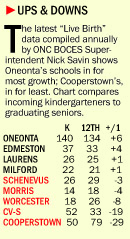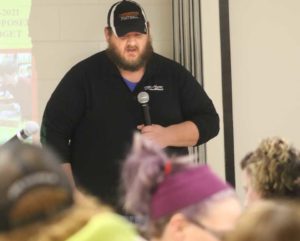‘LIVE BIRTHS’ & ENROLLMENT
Fears About Football,
Tied To Drop In Pupils

By JIM KEVLIN • Special to www.AllOTSEGO.COM
 COOPERSTOWN – Matt Phillips, CCS ’02, shared a poignant story of his family’s affection for Redskins (now Hawkeyes) football, and the 200 fans in the CCS high school auditorium applauded.
COOPERSTOWN – Matt Phillips, CCS ’02, shared a poignant story of his family’s affection for Redskins (now Hawkeyes) football, and the 200 fans in the CCS high school auditorium applauded.
“If not for football,” said Phillips, today Clark Sports Center’s Activities & Group Reservations director, “I wouldn’t have come to school.”

Cooperstown varsity football has had bad years, for sure, but always rebounded. “My senior year,” he said, “we won one game. My senior year, we were undefeated.”
Today, his daughter Leah plays with the team, continuing a family tradition. “She even talks about playing in the NFL someday.”
The term “Life Births” – a term that floated through the room as the school board contemplated a wide round of cuts to the 2020-21 budget; the budget vote and school elections is May 19 – could trump the fans’ and others’ concerns.
“We are forced to make decisions that don’t feel great,” Superintendent of Schools Bill Crankshaw said that evening: In 2007, there were 1,048 K-12 pupils; today there are 850, a 19 percent drop.
“Life Births” are compiled annually by ONC BOCES Superintendent of Schools Nick Savin for all 19 school district in his purview, nine in Otsego County. Based on the number of births in a district any one year, he projects those numbers forward: for instance, babies born in 2015 will enter kindergarten this fall.
If fewer seniors are graduating in June than kindergarteners are arriving in September – and this goes on year after year – a school district is headed for trouble.
For the 2019-20 school year, CCS has 79 students graduating, and only 50 kindergartners entering, a 37 percent drop, by far the largest among the ONC BOCES schools.
“At base, if you want a school, you have to build housing,” CCS board President Tim Hayes said in an interview, “affordable, quality housing … Until we start to create places for people to live in the community, I’m worried about the future of the community.”
Hayes served on the task force that created the Village of Cooperstown’s new Comprehensive Master Plan, approved last fall, which – to some community concern – allows larger homes to be broken up into apartments.
If there are no exterior changes, sufficient parking and other standards are met, village Zoning Enforcement Officer Jane Gentile can simply issue a permit; a project doesn’t have to go through the H-PARB, planning or zoning boards, said Deputy Mayor Cindy Falk, who has played a central role in the comp plan and resulting zoning code.
Apartment houses – the Railroad Avenue neighborhood, in particular, is designated as appropriate – still require a special permit from the Village Board, she said.
It’s only been a few months since the new zoning was approved, but Falk said she’s unaware of any house conversions or apartment complexes being proposed.
In the 1970s and ’80, Hayes said, homes were being built in the district, but in the 1990s “preserving open space was more important than building houses for people who wanted to live here.” Much of the surrounding towns of Otsego and Middlefield requires three-acre lots, he said.
That may be changing, Hayes said. In addition to Cooperstown’s new zoning, the Town of Hartwick has contracted with Delaware Engineering for a Route 28 study. The study wasn’t focused on housing, Falk said, but as survey results began coming in, housing needs were frequently mentioned.
With the largest employer in the county – Bassett Hospital, “a half-billion-dollar medical center” – just three blocks from Cooperstown Elementary, things should be different.
“Every day I see ads for employees at this medical center,” Hayes said. “We definitely don’t have enough housing for people who want to live here.”
At last week’s meeting, Hayes and Crankshaw repeatedly said no firm decisions have been made about football or anything else. The next of a series of “open budget discussions” is planned 6-6:30 p.m. Wednesday, March 4, in the high school library.
Savin, the BOCES superintendent, said that while CCS’ situation is the most dire this year, it’s not alone. “In Oneonta,” he said, “they seem to have some growth in the younger grades. Every other school in our region: They’re either staying flat or losing students.”
He continued, “In more schools, because we have declining enrollment, the school boards and communities are looking at more collaborative ways of keeping their teams. It’s appropriate, in my view.”
“That’s what the data does,” he said: “It causes the right kinds of conversations.”


They should consider significantly reducing the $7500 fee for out of district students. $1000 would keep the problems from walking in but also likely result in some kids who have parents working in the area bring them there increasing the numbers. The $7500 is really a deterrent